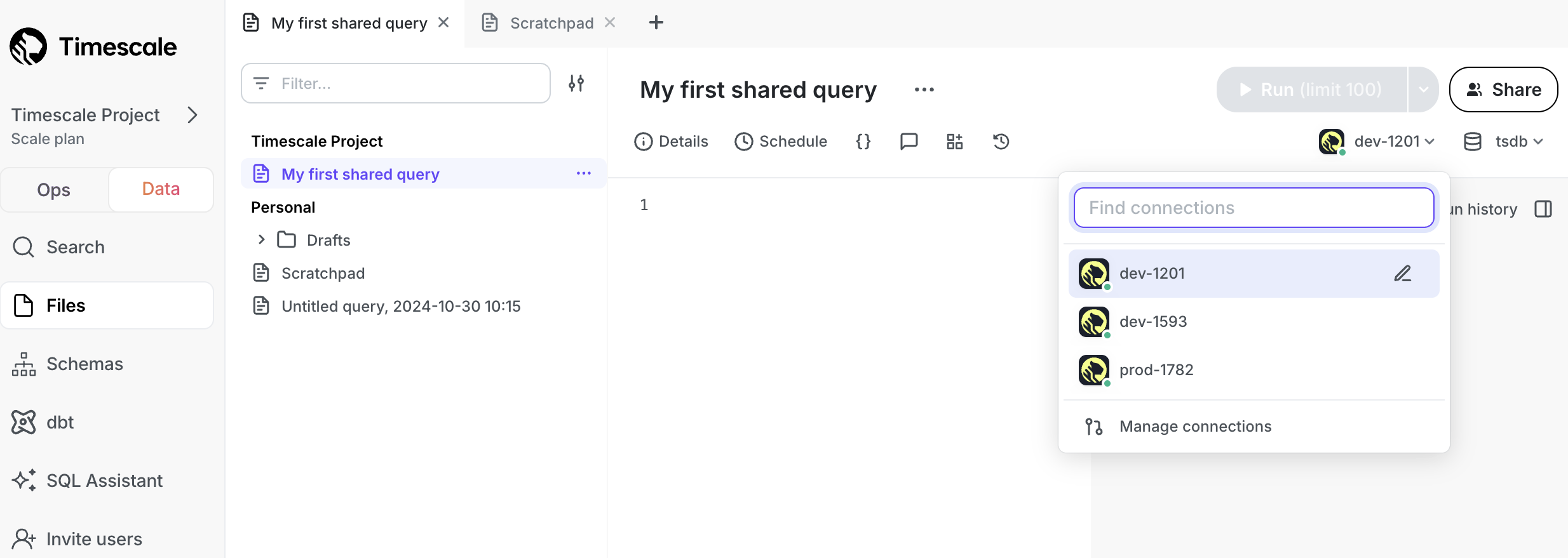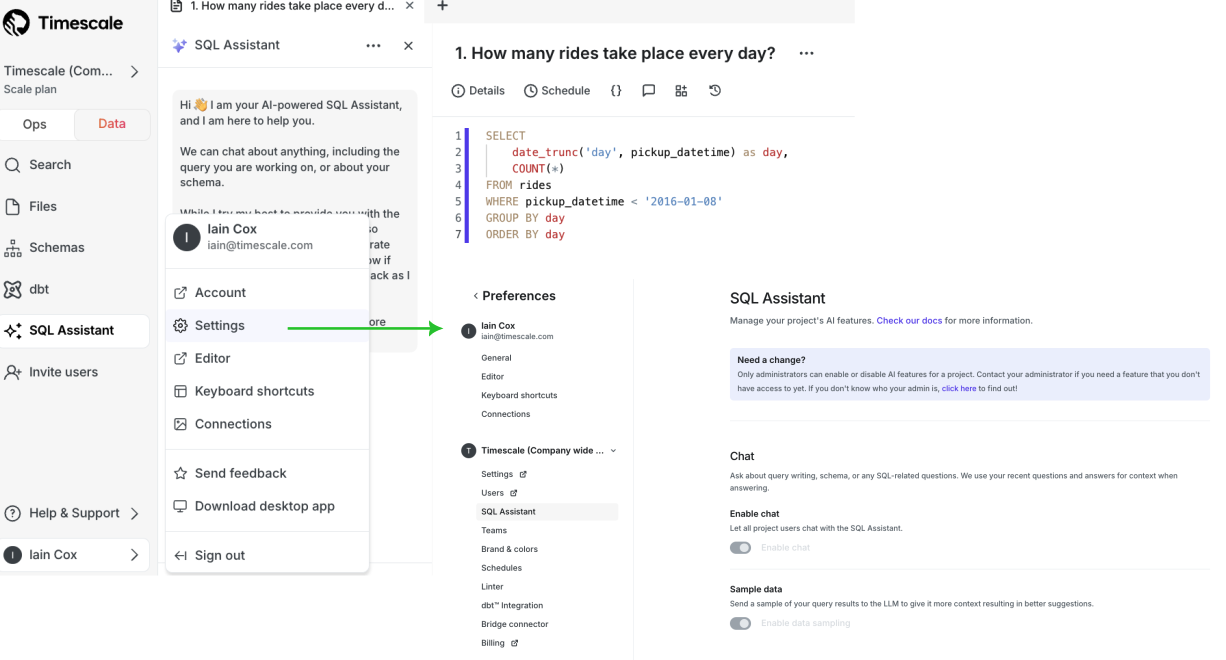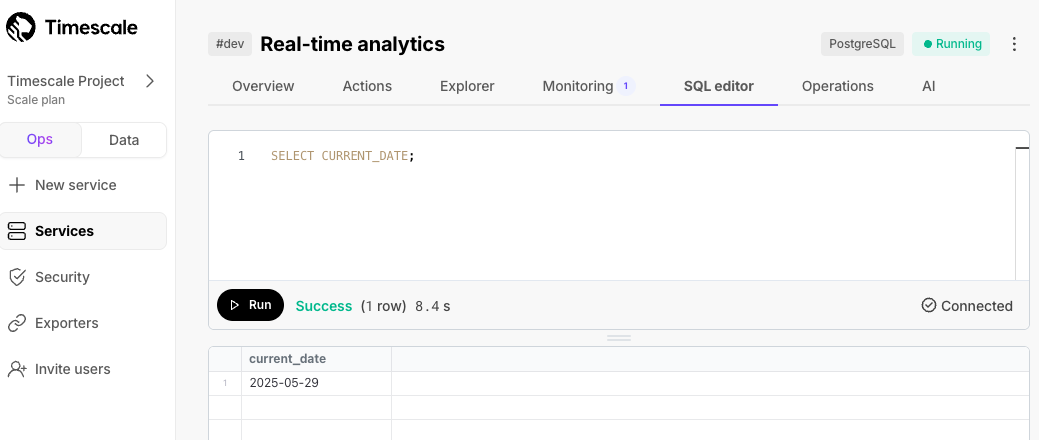Timescale Cloud: Performance, Scale, Enterprise
Self-hosted products
MST
As Timescale Cloud is based on PostgreSQL, you can use lots of different tools to connect to your service and interact with your data.
In Timescale Console you can use the following ways to run SQL queries against your service:
Data mode: a rich experience powered by PopSQL. You can write queries with autocomplete, save them in folders, share them, create charts/dashboards, and much more.
SQL assistant in the data mode: write, fix, and organize SQL faster and more accurately.
SQL editor in the ops mode: a simple SQL editor in the ops mode that lets you run ad-hoc ephemeral queries. This is useful for quick one-off tasks like creating an index on a small table or inspecting
pg_stat_statements.
If you prefer the command line to the ops mode SQL editor in Timescale Console, use psql.
You use the data mode in Timescale Console to write queries, visualize data, and share your results.

Available features are:
- Real-time collaboration: work with your team directly in the data mode query editor with live presence and multiple cursors.
- Schema browser
: understand the structure of your service and see usage data on tables and columns.
- SQL assistant: write, fix, and organize SQL faster and more accurately using AI.
- Autocomplete: get suggestions as you type your queries.
- Version history
: access previous versions of a query from the built-in revision history, or connect to a git repo.
- Charts
: visualize data from inside the UI rather than switch to Sheets or Excel.
- Schedules
: automatically refresh queries and dashboards to create push alerts.
- Query variables
: use Liquid to parameterize your queries or use
ifstatements. - Cross-platform support: work from Timescale Console
or download the desktop app
for macOS, Windows, and Linux.
- Easy connection: connect to Timescale Cloud, PostgreSQL, Redshift, Snowflake, BigQuery, MySQL, SQL Server, and more
.
To connect to a service:
Check your service is running correctly
In Timescale Console
, check that your service is marked as
Running:
Connect to your service
In the data mode
in Timescale Console, select a service in the connection drop-down:

Run a test query
Type
SELECT CURRENT_DATE;inScratchpadand clickRun:
Quick recap. You:
- Manage your services in the ops mode in Timescale Console
- Manage your data in the data mode in Timescale Console
- Store configuration and security information in your config file.
Now you have used the data mode in Timescale Console, see how to easily do the following:
- Write a query
- Share a query with your teammates
- Create a chart from your data
- Create a dashboard of multiple query results
- Create schedules for your queries
If your Timescale Cloud service runs inside a VPC, do one of the following to enable access for the PopSQL desktop app:
- Use PopSQL's bridge connector
.
- Use an SSH tunnel: when you configure the connection in PopSQL, under
Advanced OptionsenableConnect over SSH. - Add PopSQL's static IPs (
23.20.131.72, 54.211.234.135) to your allowlist.
The number of data mode seats you are allocated depends on your pricing plan.
There are a few factors to consider:
- What instance size is your service?
- How many users are running queries?
- How computationally intensive are the queries?
If you have a small number of users running performant SQL queries against a service with sufficient resources, then there should be no degradation to performance. However, if you have a large number of users running queries, or if the queries are computationally expensive, best practice is to create a read replica and send analytical queries there.
If you'd like to prevent write operations such as insert or update, instead
of using the tsdbadmin user, create a read-only user for your service and
use that in the data mode.
SQL assistant in Timescale Console is a chat-like interface that harnesses the power of AI to help you write, fix, and organize SQL faster and more accurately. Ask SQL assistant to change existing queries, write new ones from scratch, debug error messages, optimize for query performance, add comments, improve readability—and really, get answers to any questions you can think of.
SQL assistant offers a range of features to improve your SQL workflow, including:
Real-time help: SQL assistant provides in-context help for writing and understanding SQL. Use it to:
- Understand functions: need to know how functions like
LAG()orROW_NUMBER()work? SQL assistant explains it with examples. - Interpret complex queries: SQL assistant breaks down dense queries, giving you a clear view of each part.
- Understand functions: need to know how functions like
Error resolution: SQL assistant diagnoses errors as they happen, you can resolve issues without leaving your editor. Features include:
- Error debugging: if your query fails, SQL assistant identifies the issue and suggests a fix.
- Performance tuning: for slow queries, SQL assistant provides optimization suggestions to improve performance immediately.
Query organization: to keep your query library organized, and help your team understand the purpose of each query, SQL assistant automatically adds titles and summaries to your queries.
Agent mode: to get results with minimal involvement from you, SQL assistant autopilots through complex tasks and troubleshoots its own problems. No need to go step by step, analyze errors, and try out solutions. Simply turn on the agent mode in the LLM picker and watch SQL assistant do all the work for you. Recommended for use when your database connection is configured with read-only credentials.
SQL assistant supports a large number of LLMs, including:
- GPT-4o mini
- GPT-4o
- GPT-4.1 nano
- GPT-4.1 mini
- GPT-4.1
- o4-mini (low)
- o4-mini
- o4-mini (high)
- o3 (low)
- o3
- o3 (high)
- Claude 3.5 Haiku
- Claud 3.7 Sonnet
- Claud 3.7 Sonnet (extended thinking)
- Llama 3.3 70B Versatile
- Llama 3.3 70B Instruct
- Llama 3.1 405B Instruct
- Llama 4 Scout
- Llama 4 Maverick
- DeepSeek R1 Distill - Llama 3.3. 70B
- DeepSeek R1
- Gemini 2.0 Flash
- Sonnet 4
- Sonnet 4 (extended thinking)
- Opus 4
- Opus 4 (extended thinking)
Choose the LLM based on the particular task at hand. For simpler tasks, try the smaller and faster models like Gemini Flash, Haiku, or o4-mini. For more complex tasks, try the larger reasoning models like Claude Sonnet, Gemini Pro, or o3. We provide a description of each model to help you decide.
For best results with SQL assistant:
- Schema awareness: SQL assistant references schema data but may need extra context in complex environments. Specify tables, columns, or joins as needed.
- Business logic: SQL assistant does not inherently know specific business terms such as active user. Define these terms clearly to improve results.
Security and privacy is prioritized in Timescale Console. In data mode, project members
manage SQL assistant settings under
User name > Settings > SQL Assistant.

SQL assistant settings are:
- Opt-in features: all AI features are off by default. Only members of your Timescale Cloud project can enable them.
- Data protection: your data remains private as SQL assistant operates with strict security protocols. To provide AI support, Timescale may share your currently open SQL document, some basic metadata about your database, and portions of your database schema. By default, Timescale does not include any data from query results, but you can opt in to include this context to improve the results.
- Sample data: to give the LLM more context so you have better SQL suggestions, enable sample data sharing in the SQL assistant preferences.
- Telemetry: to improve SQL assistant, Timescale collects telemetry and usage data, including prompts, responses, and query metadata.
SQL editor is an integrated secure UI that you use to run queries and see the results for a Timescale Cloud service.

To enable or disable SQL editor in your service, click Operations > Service management, then
update the setting for SQL editor.
To use SQL editor:
Open SQL editor from Timescale Console
In the ops mode
in Timescale Console, select a service, then click
SQL editor.
Run a test query
Type
SELECT CURRENT_DATE;in the UI and clickRun. The results appear in the lower window:
- SQL editor in the ops mode: free for anyone with a Timescale Cloud account.
- Data mode: the number of seats you are allocated depends on your pricing plan
. SQL assistant is currently free for all users. In the future, limits or paid options may be introduced as we work to build the best experience.
- PopSQL standalone: there is a free plan available to everyone, as well as paid plans. See PopSQL Pricing
for full details.
What next? Try the main features offered by Timescale, see the use case tutorials, interact with the data in your Timescale Cloud service using your favorite programming language, integrate your Timescale Cloud service with a range of third-party tools, plain old Use Timescale, or dive into the API.
Found an issue on this page?Report an issue or Edit this page
in GitHub.